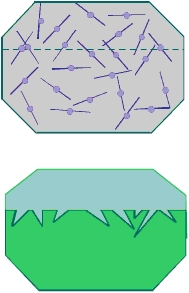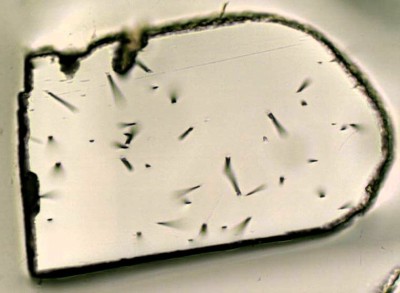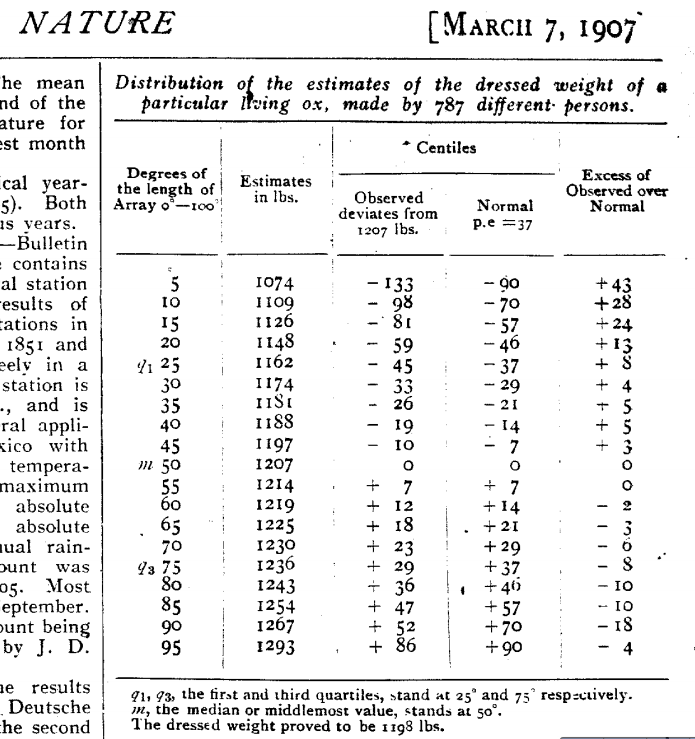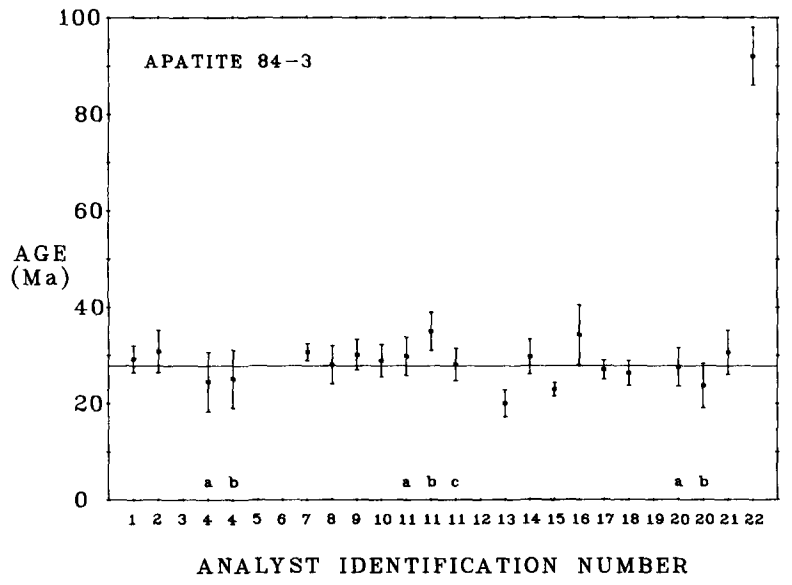geochron@home:
a crowd-sourcing app for fission track dating
Introduction to the fission track method
Apatite and zircon are two minerals which are commonly found in rocks such as granite, sandstone and gneiss, and contain up to 0.1 weight percent of uranium. 99.9998% of this naturally occurring uranium undergoes radioactive decay by disintegrating into eight He-nuclei and a Pb atom at a precisely known rate, forming the basis of the U-Pb and U-Th-He clocks. The remaining 0.0002% of the uranium undergoes spontaneous fission, forming the basis of fission track geochronology. Spontaneous fission is the process whereby a heavy and unstable atom disintegrates into two particles of roughly equal size, which move in opposite directions through the crystal lattice of the host mineral, creating a damage trail of 10-15μm length (Figure 1). With time, the density (tracks per unit area) of these so-called 'fission tracks' increases at a rate that is proportional to the U-concentration of the mineral. Although fission tracks are are too small to see with even the most sensitive microscopes, they can easily be revealed by acid etching. An age can be calculated by (a) counting the surface density (in tracks per unit area) of the fission tracks with an optical microscope, (b) mathematically converting this surface density to a volume density (tracks per unit volume), and (c) measuring the U-content (atoms per unit volume) of the same surface. geochron@home aims to crowd-source the first step in this procedure in order to improve the accuracy of the fission track method.
(a) (b)
(b)
Figure 1 (a) top: spontaneous fission of 238U damages the crystal lattice of minerals, bottom: polishing mineral grains to reveal an internal surface and etching it with acid reveals the fission tracks to the human eye; (b) a real-world example of fission tracks in apatite.
 (b)
(b)
Figure 1 (a) top: spontaneous fission of 238U damages the crystal lattice of minerals, bottom: polishing mineral grains to reveal an internal surface and etching it with acid reveals the fission tracks to the human eye; (b) a real-world example of fission tracks in apatite.
The benefits of crowd-sourcing
In 1906, Sir Francis Galton visited a county fair in which a contest was held to guess the weight of an ox. 787 villagers participated in the event. Galton discovered that the average of all their estimates (1,197 lbs) was significantly closer to the true weight of the ox (1,198 lbs) than any of the individual estimates (Figure 2a). Such is the wisdom of crowds [1,2]. Similar effects are seen in fission track geochronology, which is a geological dating technique based on the manual counting of damage tracks created by the sponteous fission of $^{238}$U in uranium-bearing minerals. A 1984 interlaboratory comparison study [3] has shown that the average of several fission track age estimates is closer to the known age of mineral standards than the age obtained by any individual observer (Figure 2b). Unfortunately, routine measurement of fission track samples by multiple analysts is prohibitively expensive in a normal laboratory environment. However, recent advances in digital microscopy enable the automated acquisition of three-dimensional 'stacks' of images, allowing fission tracks to be counted on a computer, away from the physical microscope. geochron@home uses such digital imagery in a crowd-sourcing platform for geochronological research. Taking fission track dating to a proverbial `county fair' of citizen-scientists benefits the method in three ways:- It improves the accuracy of the ages by -based on the inter-laboratory comparison study- up to 25% (Figure 2b).
- Having multiple estimates of the fission track density provides a treasure-trove of statistical data that can be used to better quantify the accuracy of legacy data.
- It accelerates the analytical process and frees up precious time for academic users.
(a) (b)
(b)
Figure 2 (a) Results of Galton (1907)'s ox-weighing experiments, and (b) the 1984 fission track calibration study. In both cases, the (geometric) mean of multiple estimates is far more accurate than any individual estimate.
 (b)
(b)
Figure 2 (a) Results of Galton (1907)'s ox-weighing experiments, and (b) the 1984 fission track calibration study. In both cases, the (geometric) mean of multiple estimates is far more accurate than any individual estimate.